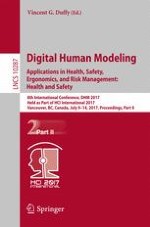The two-volume set LNCS 10286 + 10287 constitutes the refereed proceedings of the 8th International Conference on Digital Human Modeling and Applications in Health, Safety, Ergonomics, and Risk Management, DHM 2017, held as part of HCI International 2017 in Vancouver, BC, Canada.
HCII 2017 received a total of 4340 submissions, of which 1228 papers were accepted for publication after a careful reviewing process.
The 75 papers presented in these volumes were organized in topical sections as follows:
Part I: anthropometry, ergonomics, design and comfort; human body and motion modelling; smart human-centered service system design; and human-robot interaction.
Part II: clinical and health information systems; health and aging; health data analytics and visualization; and design for safety.
